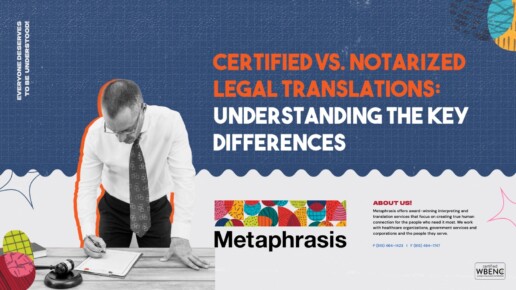Certified vs. Notarized Legal Translations: Understanding the Key Differences
When dealing with legal documents in multiple languages, accuracy and authenticity are crucial. However, many people get confused between certified and notarized legal translations. While both types of translations serve to validate documents, they have distinct purposes and processes.
In this blog, we’ll break down the difference between certified and notarized legal translations, when you need each type, and why choosing the right one is essential.
What Is a Certified Legal Translation?
A certified translation is a document translated by a professional translator or a translation agency, accompanied by a signed statement affirming that the translation is accurate and complete. The translator or the agency certifies that the translated document faithfully represents the original.
Key Features of a Certified Translation:
- Completed by a professional translator or translation agency.
- Accompanied by a signed certificate of accuracy.
- Ensures that the translation is complete and true to the original document.
- Required for official documents such as birth certificates, marriage licenses, academic transcripts, and immigration papers.
When Do You Need a Certified Translation?
Certified translations are often required in legal, governmental, and academic settings. Here are some common scenarios:
- Immigration Applications: The U.S. Citizenship and Immigration Services (USCIS) requires all foreign language documents to be accompanied by a certified translation.
- Legal Proceedings: Court cases involving international parties often require certified translations of evidence or testimonies.
- Academic Purposes: Universities may require certified translations of transcripts and diplomas for foreign students.
What Is a Notarized Legal Translation?
A notarized translation goes one step further than a certified translation. It involves a notary public, a government-authorized official who verifies the identity of the translator and witnesses their signature on the certification statement. However, the notary does not check the translation for accuracy; they only verify that the translator signed the document.
Key Features of a Notarized Translation:
- Includes a notary’s seal and signature.
- Focuses on authentication of the translator’s identity rather than the accuracy of the translation.
- Often required for documents used in foreign governments, educational institutions, or legal matters.
When Do You Need a Notarized Translation?
- International Business Transactions: Companies working with foreign partners may need notarized translations for contracts and agreements.
- Educational Documents: Some foreign universities require notarized translations of diplomas and transcripts.
- Official Government Use: Some countries require notarized translations for visas, work permits, and other official documents.
Key Differences Between Certified and Notarized Translations
|
Certified vs. Notarized: Which One Do You Need?
Choosing between a certified and notarized translation depends on your specific needs:
- If your document is for USCIS, legal courts, or universities, a certified translation is usually sufficient.
- If your document is for a foreign government, business transactions, or international academic purposes, you might need a notarized translation.
- In some cases, you may need both a certified and notarized translation.
Examples of Different Use Cases
- Applying for a Green Card? → You need a certified translation for immigration purposes.
- Sending a contract to a foreign business partner? → You may need a notarized translation.
- Submitting academic transcripts to a foreign university? → Some institutions require notarized translations, while others accept certified translations.
Common Misconceptions About Certified and Notarized Translations
- “A notary checks the accuracy of the translation.”
- False! A notary public only verifies the translator’s signature—they do not assess whether the translation is accurate.
- “Notarized translations are always better than certified ones.”
- Not true. In many cases, a certified translation is enough, and notarization is unnecessary.
- “Only government agencies require notarized translations.”
- Wrong. Some private institutions, including universities and businesses, also request notarized translations.
How to Get a Certified or Notarized Translation?
Steps to Get a Certified Translation:
- Hire a Professional Translator – Choose a certified translator or a reputable translation agency.
- Receive a Certificate of Accuracy – The translator provides a statement verifying the accuracy of the translation.
- Submit the Document – Send the certified translation to the relevant organization.
Steps to Get a Notarized Translation:
- Obtain a Certified Translation – First, complete the certified translation process.
- Visit a Notary Public – The translator must sign the certificate of accuracy in front of a notary.
- Receive the Notary’s Seal – The notary public stamps and signs the document, making it officially notarized.
- Submit the Document – Send the notarized translation to the required institution.
Conclusion
Understanding the difference between certified and notarized translations is essential for ensuring your documents meet legal and institutional requirements. Certified translations focus on accuracy and are commonly used for immigration, legal, and academic purposes. Notarized translations, on the other hand, add an extra layer of authentication and are often needed for international business and foreign government use.
Before getting a translation, always check with the receiving institution to determine whether you need a certified translation, a notarized translation, or both. This will save you time, money, and potential delays.

